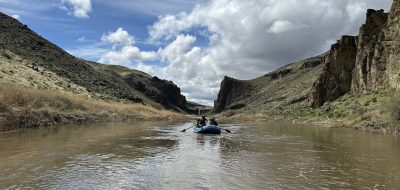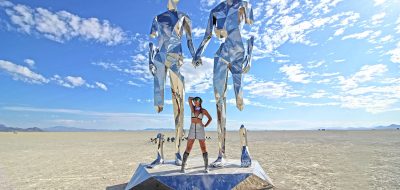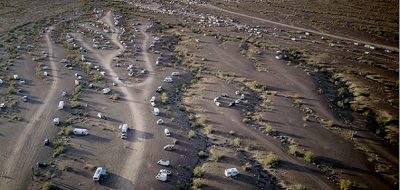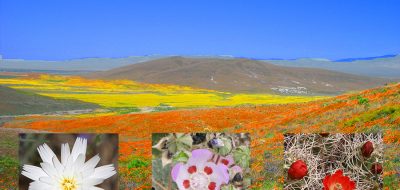By Bob Difley
As if frozen in time, the coyote stood motionless, muscles taut, eyes focused straight ahead. I followed his gaze, but could not see what had captured his attention. Suddenly he shot forward. Two wide-eyed jack rabbits exploded out of the brush, scattering in different directions. A cottontail sprinted for his burrow and disappeared into the darkness. Foiled from capturing his prey, the coyote stopped, gave me a once over, and slowly loped away to try his hunting techniques on another potential meal.
Ever since my first desert camping trip the abundance of life in the desert has amazed me. I can still vividly see my first desert coyote, standing out on the bajada, a few hundred yards from Death Valley’s Stovepipe Wells campground, delivering a lengthy tirade of yips, barks, and howls.
And the roadrunner, that watched secretly from the dense foliage of the tamarisk tree that shaded my picnic table, until I moved the right distance away and he would jump down onto the table, snatch a goodie, and run off into the safety of the brush.
My previous impressions of the desert had been of a dry, treeless, lifeless, tortuously hot, uninteresting, expanse. How effectively the coyote and roadrunner proved my naïveté. As a snowbird, I’ve traveled, hiked, and camped in all four American deserts of the Southwest, each with its own characteristic animals, wildflowers, trees, shrubs, geology, mountains, arroyos, and valleys.
The American Deserts
Dryness alone does not describe a desert. It must also have a high evaporation rate, as well as under ten inches of precipitation a year. The sparseness of plants also typify a desert, since the inadequate moisture will not support dense plant colonies. All four of North America’s deserts lie in the Southwest between the Rocky Mountains and the Sierra Nevadas. They can be divided into the hot deserts – Mojave, Sonoran, and Chihuahuan – and the cold desert, the Great Basin, covering most of Nevada, southeastern Oregon, southern Idaho, and western Utah, It’s a desert where more than half the annual precipitation falls as snow.
The Great Basin’s climate does not attract hordes of snowbirds. I spent parts of a couple winters in the Great Basin, at Valley of Fire State Park north of Las Vegas. It snowed once on Christmas Day and my propane heater ran almost constantly.
The Mojave of Southern California, the smallest of the four, owns the record for the highest temperature (134 degrees) and the lowest elevation in the US, both in Death Valley. Some authorities also identify the Colorado Desert, an area between the Mojave and Sonoran as another desert, though both the Mojave and the Colorado are arguably transitions between the Great Basin and Sonoran Deserts.
The Sonoran Desert occupies the southern part of Arizona, with two-thirds of it in Mexico. Characterized by the saguaro cactus, which grows naturally only in the Sonoran, this sub-tropical desert also contains more diverse and a greater quantity of plants and animals than the other deserts.
The Chihuahuan Desert also lies mostly in Mexico, but in New Mexico and extreme Southwestern Arizona it extends as fingers into the basins separating the mountain ranges, and also in Southwestern Texas at Big Bend and between the cities of El Paso and Pecos. The Chihuahuan is a high desert, consisting of many mountains that extend to 6500 feet in Mexico. Its lowest point is along the Rio Grande River in Texas at 1000 feet.
Next week: Snowbirding and boondocking in the Southwestern deserts.
For more RVing articles and tips take a look at my Healthy RV Lifestyle website, where you will also find my ebooks: BOONDOCKING: Finding the Perfect Campsite on America’s Public Lands (PDF or Kindle), 111 Ways to Get the Biggest Bang for your RV Lifestyle Buck (PDF or Kindle), and Snowbird Guide to Boondocking in the Southwestern Deserts (PDF or Kindle), and my newest, The RV Lifestyle: Reflections of Life on the Road (Kindle reader version).






